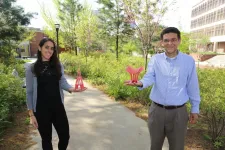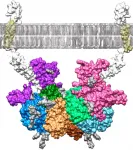Predicting the next pandemic virus is harder than we think
2021-04-20
(Press-News.org) The observation that most of the viruses that cause human disease come from other animals has led some researchers to attempt "zoonotic risk prediction" to second-guess the next virus to hit us. However, in an Essay publishing April 20th in the open access journal PLOS Biology, led by Dr Michelle Wille at the University of Sydney, Australia with co-authors Jemma Geoghegan and Edward Holmes, it is proposed that these zoonotic risk predictions are of limited value and will not tell us which virus will cause the next pandemic. Instead, we should target the human-animal interface for intensive viral surveillance.
So-called zoonotic viruses have caused epidemics and pandemics in humans for centuries. This is exactly what is occurring today with the COVID-19 pandemic: the novel coronavirus responsible for this disease - SARS-CoV-2 - emerged from an animal species, although exactly which species is uncertain.
Therefore, a key question is whether we can predict which animal or which virus group will most likely cause the next pandemic? This has led researchers to attempt "zoonotic risk prediction," in which they attempt to determine which virus families and host groups are most likely to carry potential zoonotic and/or pandemic viruses.
Dr Wille and her colleagues identify several key problems with zoonotic risk prediction attempts.
First, they're based on tiny data sets. Despite decades of work, we have probably identified less than 0.001% of all viruses, even from the mammalian species from which the next pandemic virus will likely emerge.
Second, these data are also highly biased towards those viruses that most infect humans or agricultural animals, or are already known to zoonotic. The reality is that most animals have not been surveyed for viruses, and that viruses evolve so quickly that any such surveys will soon be out of date and so of limited value.
The authors instead argue that a new approach is needed, involving the extensive sampling of animals and humans at the places where they interact - the animal-human interface. This will enable novel viruses to be detected as soon as they appear in humans and before they establish pandemics. Such enhanced surveillance may help us prevent something like COVID-19 ever happening again.
INFORMATION:
In your coverage please use these URLs to provide access to the freely available articles in PLOS Biology: http://journals.plos.org/plosbiology/article?id=10.1371/journal.pbio.3001135
Citation: Wille M, Geoghegan JL, Holmes EC (2021) How accurately can we assess zoonotic risk? PLoS Biol 19(4): e3001135. https://doi.org/10.1371/journal.pbio.3001135
Funding: E.C.H. is funded by an Australian Research Council Australian Laureate Fellowship (FL170100022). M.W. is supported by an Australian Research Council Discovery Early Career Researcher Award (DE200100977). The funders had no role in study design, data collection and analysis, decision to publish, or preparation of the manuscript.
Competing Interests: The authors have declared that no competing interests exist
[Attachments] See images for this press release:

ELSE PRESS RELEASES FROM THIS DATE:
2021-04-20
In many species, including humans and mice, the fluctuating levels of the hormones progesterone and estrogen determine whether the female is fertile or not. And in the case of mice, whether she's sexually receptive or not.
The change in receptivity is striking. Female mice shift from accepting sexual partners to aggressively rejecting them across a cycle of six short days. How can the female reproductive hormones bring about such a radical behavioural change?
When searching for an explanation, the team of Susana Lima, a principal investigator at the Champalimaud Centre for the Unknown in Portugal, came across an intriguing discovery.
"Our experiments revealed that a brain area important for female receptivity, called the VMH (ventromedial ...
2021-04-20
A chemist from Purdue University has found a way to synthesize a compound to fight a previously "undruggable" cancer protein with benefits across a myriad of cancer types.
Inspired by a rare compound found in a shrub native to North America, Mingji Dai, professor of chemistry and a scientist at the Purdue University Center for Cancer Research, studied the compound and discovered a cost-effective and efficient way to synthesize it in the lab. The compound -- curcusone D -- has the potential to help combat a protein found in many cancers, including some forms of breast, brain, colorectal, prostate, lung and liver cancers, among others. The protein, dubbed BRAT1, had previously been deemed "undruggable" for its chemical properties. In collaboration with Alexander Adibekian's ...
2021-04-20
Astronauts who spend extended time in space face stressors such as isolation, confinement, lack of privacy, altered light-dark cycles, monotony and separation from family. Interestingly, so do people who work at international research stations in Antarctica, where the extreme environment is characterized by numerous stressors that mirror those present during long-duration space exploration.
To better understand the psychological hurdles faced by astronauts, University of Houston professor of psychology Candice Alfano and her team developed the Mental Health Checklist (MHCL), a self-reporting instrument for detecting ...
2021-04-20
A Texas A&M researcher is discovering the demographic characteristics that can produce or lessen stress for racial and ethnic minority students in school settings.
The study, recently published in the journal Ethnicity and Disease, collected mental health survey assessments among 389 sixth-graders from 14 Texas public schools in urban areas. Melissa DuPont-Reyes, assistant professor at the Texas A&M University School of Public Health, led the investigation of self-reported depressive-anxious symptoms over a two-year period. This issue of the journal highlighted research by early stage investigators, especially scholars of color, to advance new knowledge ...
2021-04-20
A mollusk and shrimp are two unlikely marine animals that are playing a very important role in engineering. The bodies of both animals illustrate how natural features, like the structures of their bones and shells, can be borrowed to enhance the performance of engineered structures and materials, like bridges and airplanes. This phenomenon, known as biomimetics, is helping advance structural topology research, where the microscale features found in natural systems are being mimicked.
In a recent paper published by researchers at the Georgia Institute of Technology and the Pontifical Catholic University of Rio de ...
2021-04-20
WASHINGTON, April 20, 2021 -- Fiber optic technology is the holy grail of high-speed, long-distance telecommunications. Still, with the continuing exponential growth of internet traffic, researchers are warning of a capacity crunch.
In AVS Quantum Science, by AIP Publishing, researchers from the National Institute of Standards and Technology and the University of Maryland show how quantum-enhanced receivers could play a critical role in addressing this challenge.
The scientists developed a method to enhance receivers based on quantum physics properties to dramatically increase network ...
2021-04-20
Researchers at Johannes Gutenberg University Mainz (JGU) in Germany and the Institute of Molecular Biology of Barcelona in Spain have discovered how the blood plasma protein fetuin-B binds to the enzyme meprin β and used a computer model to visualize their findings. These results could lead to the development of new drugs to treat serious diseases such as Alzheimer's and cancer. Meprin β releases proteins from cell membranes, thus controlling important physiological functions in the human body. However, a dysregulation of this process can trigger the development of Alzheimer's and ...
2021-04-20
Earthquake early warnings can be delivered successfully using a small network of off-the-shelf smartphones attached to building baseboards, according to a study conducted in Costa Rica last year.
In his presentation at the Seismological Society of America (SSA)'s 2021 Annual Meeting, Ben Brooks of the U.S. Geological Survey said the ASTUTI (Alerta Sismica Temprana Utilizando Teléfonos Inteligentes) network of more than 80 stations performed comparably to scientific-grade warning systems.
During six months' of ASTUTI operation, there were 13 earthquakes that caused noticeable ...
2021-04-20
The famous 1700 Cascadia earthquake that altered the coastline of western North America and sent a tsunami across the Pacific Ocean to Japan may have been one of a sequence of earthquakes, according to new research presented at the Seismological Society of America (SSA)'s 2021 Annual Meeting.
Evidence from coastlines, tree rings and historical documents confirm that there was a massive earthquake in the U.S. Cascadia Subduction Zone on 26 January 1700. The prevailing hypothesis is that one megathrust earthquake, estimated at magnitude 8.7 to 9.2 and involving the entire tectonic plate boundary in the region, was responsible ...
2021-04-20
When hydraulic fracturing operations ground to a halt last spring in the Kiskatinaw area of British Columbia, researchers expected seismic quiescence in the region. Instead, hundreds of small earthquakes occurred for months after operations shut down, according to a new study.
In her presentation at the Seismological Society of America (SSA)'s 2021 Annual Meeting, Rebecca Salvage of the University of Calgary said about 65% of these events could not be attributed to either natural seismicity or active fluid injection from hydraulic fracturing operations.
Salvage and her colleagues instead suggest the latent earthquakes may be the result of aseismic slip, driven by fluid from previous hydraulic fracture injections keeping rock pore pressures elevated.
"Because there are lots of faults ...
LAST 30 PRESS RELEASES:
[Press-News.org] Predicting the next pandemic virus is harder than we think






